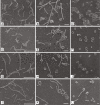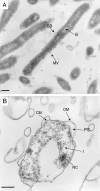Adaptive response to starvation in the fish pathogen Flavobacterium columnare: cell viability and ultrastructural changes
- PMID: 23163917
- PMCID: PMC3517764
- DOI: 10.1186/1471-2180-12-266
Adaptive response to starvation in the fish pathogen Flavobacterium columnare: cell viability and ultrastructural changes
Abstract
Background: The ecology of columnaris disease, caused by Flavobacterium columnare, is poorly understood despite the economic losses that this disease inflicts on aquaculture farms worldwide. Currently, the natural reservoir for this pathogen is unknown but limited data have shown its ability to survive in water for extended periods of time. The objective of this study was to describe the ultrastructural changes that F. columnare cells undergo under starvation conditions. Four genetically distinct strains of this pathogen were monitored for 14 days in media without nutrients. Culturability and cell viability was assessed throughout the study. In addition, cell morphology and ultrastructure was analyzed using light microscopy, scanning electron microscopy, and transmission electron microscopy. Revival of starved cells under different nutrient conditions and the virulence potential of the starved cells were also investigated.
Results: Starvation induced unique and consistent morphological changes in all strains studied. Cells maintained their length and did not transition into a shortened, coccus shape as observed in many other Gram negative bacteria. Flavobacterium columnare cells modified their shape by morphing into coiled forms that comprised more than 80% of all the cells after 2 weeks of starvation. Coiled cells remained culturable as determined by using a dilution to extinction strategy. Statistically significant differences in cell viability were found between strains although all were able to survive in absence of nutrients for at least 14 days. In later stages of starvation, an extracellular matrix was observed covering the coiled cells. A difference in growth curves between fresh and starved cultures was evident when cultures were 3-months old but not when cultures were starved for only 1 month. Revival of starved cultures under different nutrients revealed that cells return back to their original elongated rod shape upon encountering nutrients. Challenge experiments shown that starved cells were avirulent for a fish host model.
Conclusions: Specific morphological and ultrastructural changes allowed F. columnare cells to remain viable under adverse conditions. Those changes were reversed by the addition of nutrients. This bacterium can survive in water without nutrients for extended periods of time although long-term starvation appears to decrease cell fitness and resulted in loss of virulence.
Figures







References
-
- Austin B, Austin DA. Bacterial fish pathogens: disease of farmed and wild fish. New York, NY: Springer; 1999.
-
- Decostere A, Haesebrouck F, Van Driessche E, Charlier G, Ducatelle R. Characterization of the adhesion of Flavobacterium columnare (Flexibacter columnaris) to gill tissue. J Fish Dis. 1999;22:465–474. doi: 10.1046/j.1365-2761.1999.00198.x. - DOI
Publication types
MeSH terms
Substances
LinkOut - more resources
Full Text Sources
Other Literature Sources
Molecular Biology Databases

